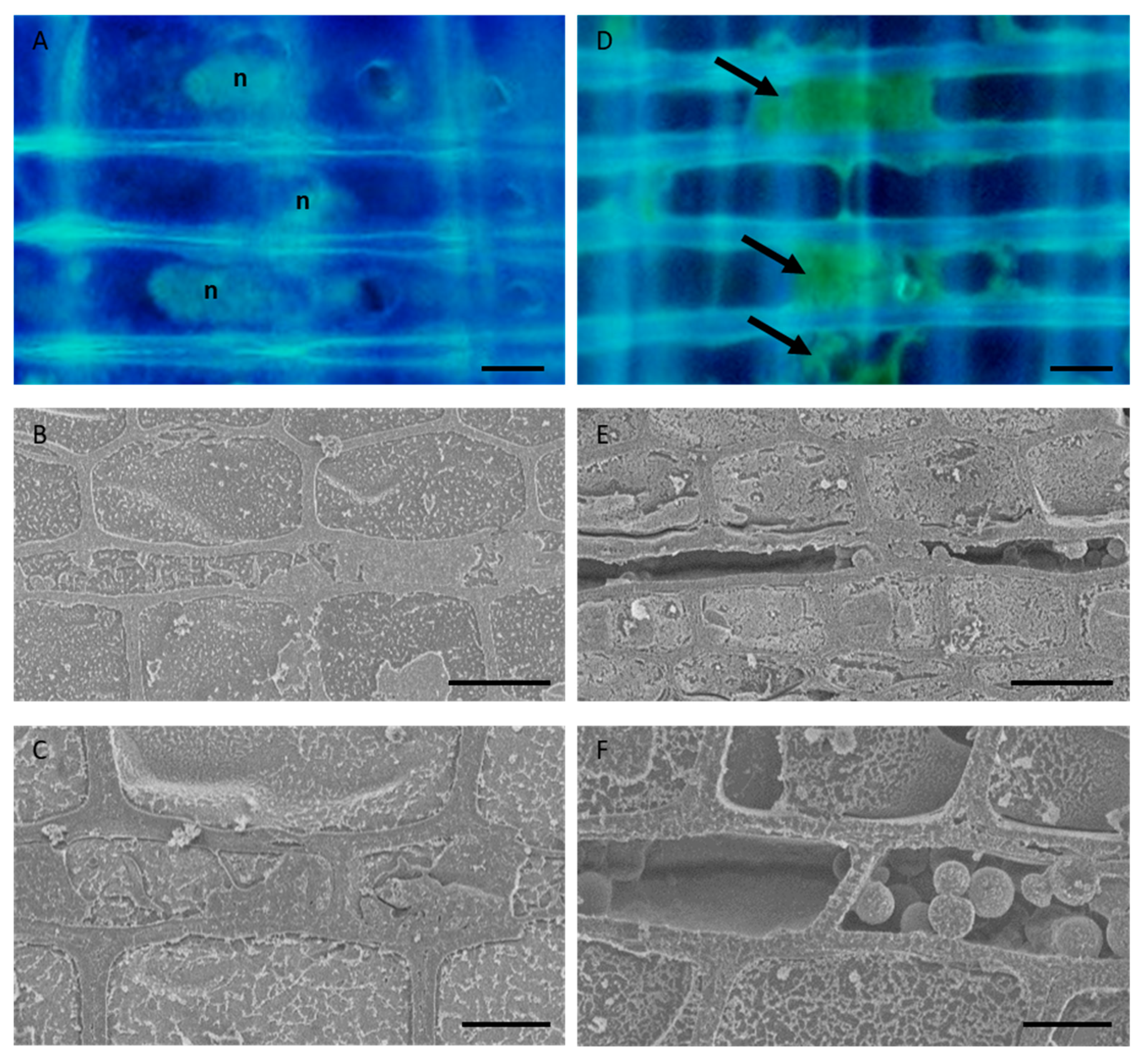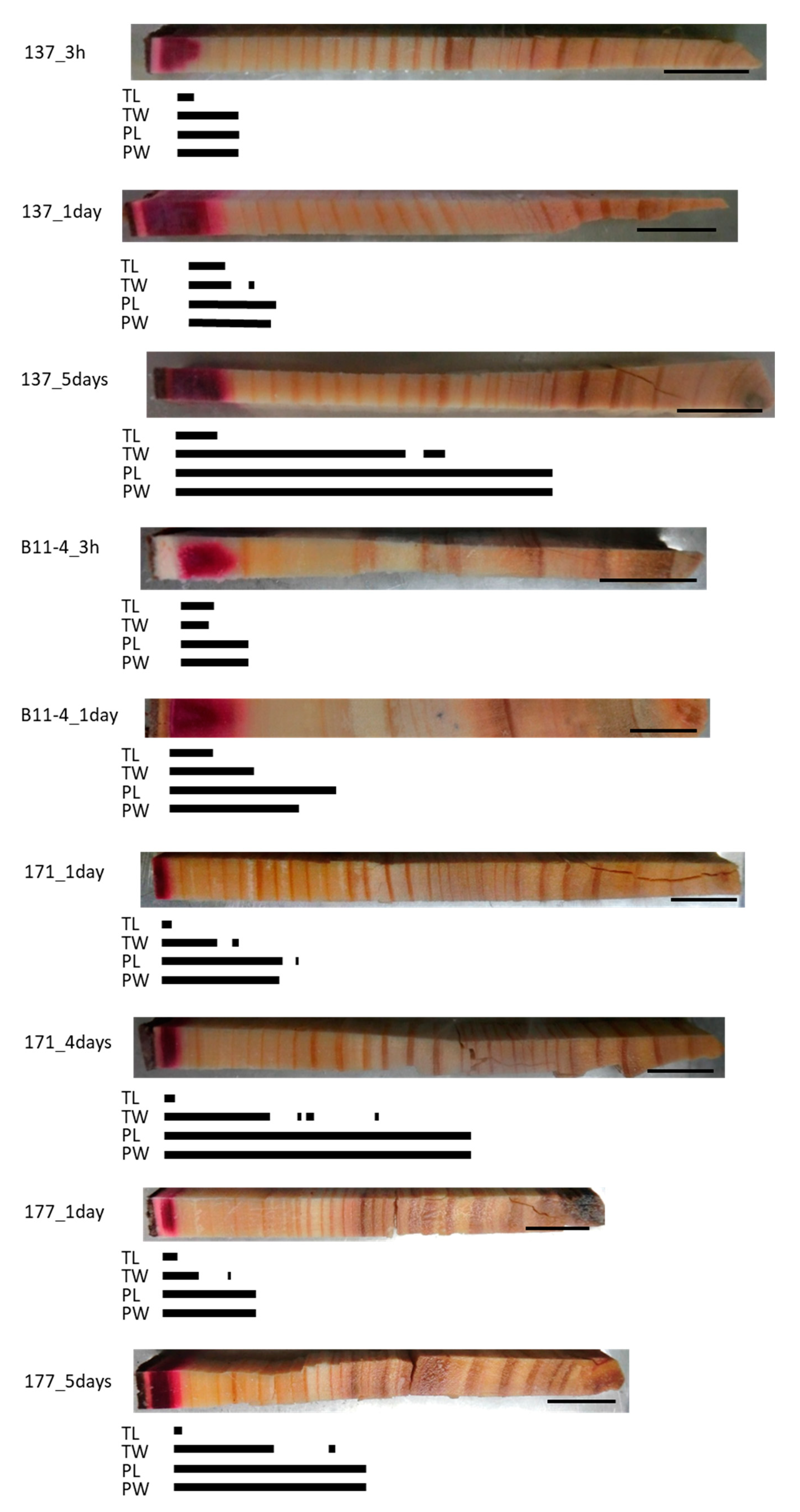Radial Movement of Minerals in the Trunks of Standing Japanese Cedar (Cryptomeria Japonica D. Don) Trees in Summer by Tracer Analysis
Abstract
:1. Introduction
2. Materials and Methods
2.1. Plant Materials
2.2. Fluorescence Microscopic Examination of Cell Morphology
2.3. Preparation of the Cs Solution for Standing Tree Injection
2.4. Cs Injection and Sample Collection
2.5. Cryo-SEM/EDX
2.6. Cs Concentration
3. Results
3.1. Parenchyma Cell Structure of Normal and Freeze–Thaw-Treated Samples
3.2. Cs Distribution in the Freeze–Thaw-Treated Samples
3.3. Cs Distribution in the Normal Samples
3.4. Quantitative Analysis by ICP-MS
4. Discussion
4.1. Mechanism of Radial Movement in the Trunks of Standing Japanese Cedar Trees
4.2. Effects of Season and the Injection Duration on Radial Mineral Movement
5. Conclusions
Author Contributions
Funding
Acknowledgments
Conflicts of Interest
References
- Tyree, M.T.; Zimmermann, M.H. Xylem Structure and the Ascent of Sap; Springer: Berlin, Germany, 2002. [Google Scholar]
- Holbrook, N.M.; Zwieniecki, M.A. Integration of long distance transport systems in plants: Perspectives and prospects for future research. In Vascular Transport in Plants; Holbrook, N.M., Zwieniecki, M.A., Eds.; Elisevier Academic Press: San Diego, CA, USA, 2005; pp. 537–545. [Google Scholar]
- Sokołowska, K. Symplasmic transport in wood: The importance of living xylem cells Symplasmic Transport in Vascular Plants. In Symplasmic Transport in Vascular Plants; Sokołowska, K., Sowiński, P., Eds.; Springer Science-Business Media: New York, NY, USA, 2013; pp. 101–132. [Google Scholar]
- Sauter, J.J.; Kloth, S. Plasmodesmatal frequency and radial translocation rates in ray cells of poplar (Populus × canadensis Moench ‘robusta’). Planta 1986, 168, 377–380. [Google Scholar] [CrossRef] [PubMed]
- Van Bel, A.J.E. Xylem-phloem exchange via the rays: The undervalued route of transport. J. Exp. Bot. 1990, 41, 631–644. [Google Scholar] [CrossRef]
- Van der Schoot, C.; van Bel, A.J.E. Mapping membrane potential differences and dye-coupling in internodal tissues of tomato (Solanum lycopersicum L.). Planta 1990, 182, 9–21. [Google Scholar] [CrossRef] [PubMed]
- Sauter, J.J.; van Cleve, B. Storage, mobilization and interrelations of starch, sugars, protein and fat in the ray storage tissue of poplar trees. Trees 1994, 8, 297–304. [Google Scholar] [CrossRef]
- Chaffey, N.; Barlow, P. The cytoskeleton facilitates a three-dimensional symplasmic continuum in the long-lived ray and axial parenchyma cells of angiosperm trees. Planta 2001, 213, 811–823. [Google Scholar] [CrossRef] [PubMed]
- Okada, N.; Hirakawa, Y.; Katayama, Y. Application of activable tracers to investigate radial movement of minerals in the stem of Japanese cedar (Cryptomeria japonica). J. Wood Sci. 2011, 57, 421–428. [Google Scholar] [CrossRef]
- Okada, N.; Hirakawa, Y.; Katayama, Y. Radial movement of sapwood-injected rubidium into heartwood of Japanese cedar (Cryptomeria japonica) in the growing period. J. Wood Sci. 2012, 58, 1–8. [Google Scholar] [CrossRef]
- Sokołowska, K.; Zagórska-Marek, B. Symplasmic, long-distance transport in xylem and cambial regions in branches of Acer pseudoplatanus (Aceraceae) and Populus tremula × P. tremuloides (Salicaceae). Am. J. Bot. 2012, 99, 1745–1755. [Google Scholar] [CrossRef]
- Spicer, R. Symplasmic networks in secondary vascular tissues: Parenchyma distribution and activity supporting long-distance transport. J. Exp. Bot. 2014, 65, 1829–1848. [Google Scholar] [CrossRef] [Green Version]
- Pfautsch, S.; Renard, J.; Tjoelker, M.G.; Salih, A. Phloem as capacitor: Radial transfer of water into xylem of tree stems occurs via symplastic transport in ray parenchyma. Plant Physiol. 2015, 167, 963–971. [Google Scholar] [CrossRef] [Green Version]
- Kuroda, K.; Yamashita, K.; Fujiwara, T. Cellular level observation of water loss and the refilling of tracheids in the xylem of Cryptomeria japonica during heartwood formation. Trees 2009, 23, 1163–1172. [Google Scholar] [CrossRef]
- Kuroda, K.; Fujiwara, T.; Imai, T.; Takama, R.; Saito, K.; Matsushita, Y.; Fukushima, K. The cryo-TOF-SIMS/SEM system for the analysis of the chemical distribution in freeze-fixed Cryptomeria japonica wood. Surf. Interface Anal. 2013, 45, 215–219. [Google Scholar] [CrossRef]
- Kuroda, K.; Yamane, K.; Itoh, Y. Cellular level in planta analysis of radial movement of artificially injected caesium in Cryptomeria japonica xylem. Trees 2018, 32, 1505–1517. [Google Scholar] [CrossRef]
- Kuroda, K.; Kagawa, A.; Tonosaki, M. Radiocesium concentrations in the bark, sapwood and heartwood of three tree species collected at Fukushima forests half a year after the Fukushima Dai-ichi nuclear accident. J. Environ. Radioact. 2013, 122, 37–42. [Google Scholar] [CrossRef]
- Ohashi, S.; Kuroda, K.; Takano, T.; Suzuki, Y.; Fujiwara, T.; Abe, H.; Kagawa, A.; Sugiyama, M.; Kubojima, Y.; Zhang, C.; et al. Temporal trends in 137Cs concentrations in the bark, sapwood, heartwood, and whole wood of four tree species in Japanese forests from 2011 to 2016. J. Environ. Radioact. 2017, 178–179, 335–342. [Google Scholar] [CrossRef] [PubMed]
- Nobuchi, T.; Kuroda, K.; Iwata, R.; Harada, H. Cytological study of the seasonal features of heartwood formation of sugi (Cryptomeria japonica D. Don). Mokuzai Gakkaishi 1982, 28, 669–676. [Google Scholar]
- Nobuchi, T.; Harada, H. Physiological features of the ‘white zone’ of sugi (Cryptomeria japonica D. Don)—Cytological structure and moisture content. Mokuzai Gakkaishi 1983, 29, 824–832. [Google Scholar]
- Nakada, R.; Fujisawa, Y.; Hirakawa, Y. Soft X-ray observation of water distribution in the stem of Cryptomeria japonica D. Don. I: General description of water distribution. J. Wood Sci. 1999, 45, 188–193. [Google Scholar] [CrossRef]
- Nakaba, S.; Arakawa, I.; Morimoto, H.; Nakada, R.; Bito, N.; Imai, T.; Funada, R. Agatharesinol biosynthesis-related changes of ray parenchyma in sapwood sticks of Cryptomeria japonica during cell death. Planta 2016, 243, 1125–1236. [Google Scholar] [CrossRef]
- Sano, Y.; Okamura, Y.; Utsumi, Y. Visualizing water-conduction pathways of living trees: Selection of dyes and tissue preparation methods. Tree Physiol. 2005, 25, 269–275. [Google Scholar] [CrossRef] [Green Version]
- Umebayashi, T.; Utsumi, Y.; Koga, S.; Inoue, S.; Shiiba, Y.; Arakawa, K.; Matsumura, J.; Oda, K. Optimal conditions for visualizing water-conducting pathways in a living tree by the dye injection method. Tree Physiol. 2007, 27, 993–999. [Google Scholar] [CrossRef] [PubMed] [Green Version]
- Umebayashi, T.; Utsumi, Y.; Koga, S.; Inoue, S.; Fujikawa, S.; Arakawa, K.; Matsumura, J.; Oda, K. Conducting pathways in north temperate deciduous broadleaved trees. IAWA J. 2008, 29, 247–263. [Google Scholar] [CrossRef]
- Kudo, K.; Yasue, K.; Hosoo, Y.; Funada, R. Relationship between formation of earlywood vessels and leaf phenology in two ring-porous hardwoods, Quercus serrata and Robinia pseudoacacia, in early spring. J. Wood Sci. 2015, 61, 455–464. [Google Scholar] [CrossRef]
- Kudo, K.; Usumi, Y.; Kuroda, K.; Yamagishi, Y.; Nabeshima, E.; Nakaba, S.; Yasue, K.; Takata, K.; Funada, R. Formation of new networks of earlywood vessels in seedlings of the deciduous ring-porous hardwood Quercus serrata in springtime. Trees 2018, 32, 725–734. [Google Scholar] [CrossRef]
- Steponkus, P.L.; Lynch, D.L. Freeze/thaw-induced destabilization of the plasma membrane and the effects of cold acclimation. J. Bioenerg. Biomembr. 1989, 21, 21–41. [Google Scholar] [CrossRef] [PubMed]
- Uemura, M.; Steponkus, P.L. Effect of cold acclimation on membrane lipid composition and freeze induced membrane destabilization. In Plant Cold Hardiness: Molecular Biology, Biochemistry, and Physiology; Li, P.H., Chen, T.H.H., Eds.; Plenum Press: New York, NY, USA, 1998; pp. 171–179. [Google Scholar]
- Yamada, T.; Kuroda, K.; Jitsuyama, Y.; Takezawa, D.; Arakawa, K.; Fujikawa, S. Roles of the plasma membrane and the cell wall in the responses of plant cells to freezing. Planta 2002, 215, 770–778. [Google Scholar] [CrossRef]
- Fujikawa, S.; Kuroda, K.; Fukazawa, K. Ultrastructural study of deep supercooling of xylem ray parenchyma cells from Styrax obassia. Micron 1994, 25, 241–252. [Google Scholar] [CrossRef]
- Fujikawa, S.; Kuroda, K.; Jitsuyama, Y.; Sano, Y.; Ohtani, J. Freezing behavior of xylem ray parenchyma cells in softwood species with differences in the organization of cell walls. Protoplasma 1999, 206, 31–40. [Google Scholar] [CrossRef]
- Nakaba, S.; Morimoto, H.; Arakawa, I.; Yamagishi, Y.; Nakada, R.; Funada, R. Responses of ray parenchyma cells to wounding differ between earlywood and latewood in the sapwood of Cryptomeria japonica. Trees 2017, 31, 27–39. [Google Scholar] [CrossRef]
- Kim, J.S.; Awano, T.; Yoshinaga, A.; Takabe, K. Immunolocalization and structural variations of xylan in differentiating earlywood tracheid cell walls of Cryptomeria japonica. Planta 2010, 232, 817–824. [Google Scholar] [CrossRef]
- Kim, J.S.; Awano, T.; Yoshinaga, A.; Takabe, K. Ultrastructure of the innermost surface of differentiating normal and compression wood tracheids as revealed by field emission scanning electron microscopy. Planta 2012, 235, 1209–1219. [Google Scholar] [CrossRef] [PubMed]
- Fujikawa, S.; Ishida, S. Ultrastructure of ray parenchyma cell walls of softwood. Mokuzai Gakkaishi 1975, 21, 445–456. [Google Scholar]
- Nakada, R.; Fukatsu, E. Seasonal variation of heartwood formation in Larix kaempferi. Tree Physiol. 2012, 32, 1497–1508. [Google Scholar] [CrossRef] [PubMed] [Green Version]
- IAWA (Committee on Nomenclature International Association of Wood Anatomists). Multilingual Glossary of Terms Used in Wood Anatomy; Verlagsanstalt Buchdrucherei Konkordia: Winterthur, Switzerland, 1964. [Google Scholar]
- Fujioka, M.; Takashi, K. Sugi Shinzaishoku Koppen ni Kansuru Kenkyu (On the Cause of the Darkening of the Heartwood of Cryptomeria Japonica Don). For. Exp. Stn. Bull. FFPRI 1918, 16, 1–78. (In Japanese) [Google Scholar]
- Fujioka, M.; Takashi, K. On the Cause of the Darkening of the Heartwood of Cryptomeria Japonica Don. J. For. 1921, 19, 844–866. [Google Scholar]






| Injection | ||||||
|---|---|---|---|---|---|---|
| Tree Number | Age | Tree Height (m) | Girth at 1.2 m (cm) | Period of Injection | Starting Date (D/M/Y) | Harvesting Date (D/M/Y) |
| Injection after freeze–thawing | ||||||
| 167 | 38 | 15.7 | 49.0 | 1 day | 26/07/2018 | 27/07/2018 |
| 4 days | 23/07/2018 | 27/07/2018 | ||||
| 169 | 38 | 15.7 | 48.0 | 1 day | 26/07/2018 | 27/07/2018 |
| 4 days | 23/07/2018 | 27/07/2018 | ||||
| 173 | 38 | 16.5 | 43.0 | 1 day | 11/09/2018 | 12/09/2018 |
| 5 days | 07/09/2018 | 12/09/2018 | ||||
| 143 | 36 | 14.2 | 41.0 | 5 days | 05/08/2016 | 10/08/2016 |
| Normal injection | ||||||
| 137 | 35 | 14.6 | 46.0 | 3 h | 22/07/2015 | 22/07/2015 |
| 1 day | 21/07/2015 | 22/07/2015 | ||||
| 5 days | 17/07/2015 | 22/07/2015 | ||||
| B11-4 | 10 | 7.3 | 52.4 | 3 h | 22/07/2015 | 22/07/2015 |
| 1 day | 21/07/2015 | 22/07/2015 | ||||
| 171 | 38 | 17.5 | 55.0 | 1 day | 26/07/2018 | 27/07/2018 |
| 4 days | 23/07/2018 | 27/07/2018 | ||||
| 177 | 38 | 15.8 | 45.0 | 1 day | 11/09/2018 | 12/09/2018 |
| 5 days | 07/09/2018 | 12/09/2018 | ||||
| 101 | 35 | 14.7 | 44.5 | 60 days | 13/07/2015 | 11/09/2015 |
| B11-3 | 10 | 7.1 | 51.4 | 60 days | 13/07/2015 | 11/09/2015 |
© 2020 by the authors. Licensee MDPI, Basel, Switzerland. This article is an open access article distributed under the terms and conditions of the Creative Commons Attribution (CC BY) license (http://creativecommons.org/licenses/by/4.0/).
Share and Cite
Kuroda, K.; Yamane, K.; Itoh, Y. Radial Movement of Minerals in the Trunks of Standing Japanese Cedar (Cryptomeria Japonica D. Don) Trees in Summer by Tracer Analysis. Forests 2020, 11, 562. https://doi.org/10.3390/f11050562
Kuroda K, Yamane K, Itoh Y. Radial Movement of Minerals in the Trunks of Standing Japanese Cedar (Cryptomeria Japonica D. Don) Trees in Summer by Tracer Analysis. Forests. 2020; 11(5):562. https://doi.org/10.3390/f11050562
Chicago/Turabian StyleKuroda, Katsushi, Kenichi Yamane, and Yuko Itoh. 2020. "Radial Movement of Minerals in the Trunks of Standing Japanese Cedar (Cryptomeria Japonica D. Don) Trees in Summer by Tracer Analysis" Forests 11, no. 5: 562. https://doi.org/10.3390/f11050562
APA StyleKuroda, K., Yamane, K., & Itoh, Y. (2020). Radial Movement of Minerals in the Trunks of Standing Japanese Cedar (Cryptomeria Japonica D. Don) Trees in Summer by Tracer Analysis. Forests, 11(5), 562. https://doi.org/10.3390/f11050562





